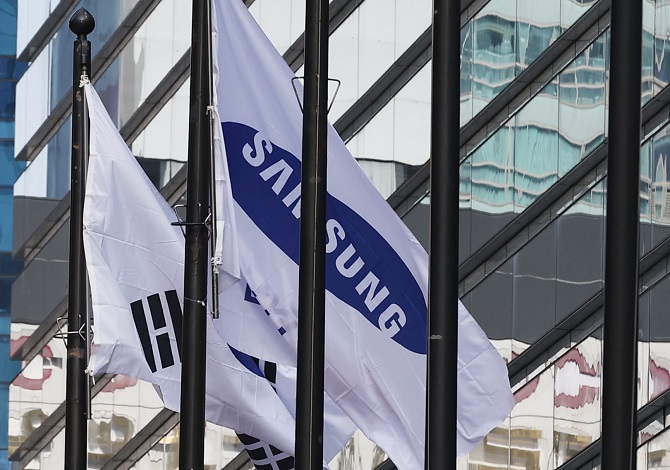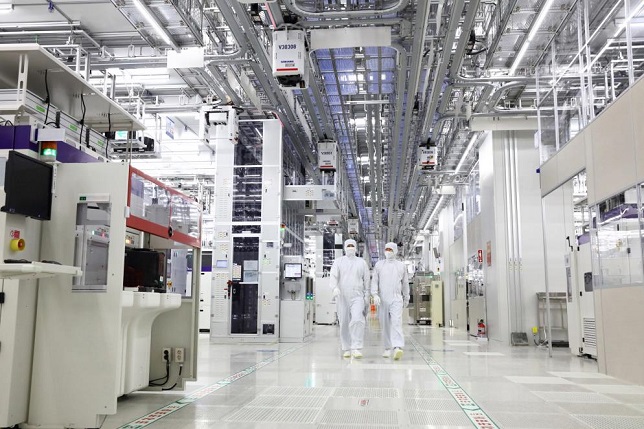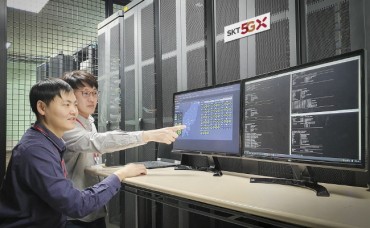
This photo, taken on Jan. 25, 2021, shows the corporate flag of Samsung Group at its office building in Seoul. (Yonhap)
SEOUL, Jan. 31 (Korea Bizwire) — Samsung Electronics Co. reaffirmed Tuesday it has no plan to cut investment for this year despite disappointing earning results in the fourth quarter on a slump in demand.
While unfavorable market conditions are expected to persist, “on the flip side, this is a great opportunity for us to prepare for the future,” the company said during an earnings call.
Samsung will “continue to make the infrastructure investments that are necessary to respond to mid-to-long term demand, and to secure the essential clean rooms that we would need to do that. So in conclusion, this year’s (capital expenditures) plan is expected to be similar to previous years,” it said.
The remark came amid wild speculation that Samsung might join the list of other major memory chip firms, including SK hynix and Micron Technology, to reduce investment and production to deal with falling prices and oversupply.
Samsung, the world’s largest memory chip and mobile phone maker, also forecast the portion of research and development investment within its total capex will rise this year “in order to enhance our process technology competitiveness and stabilize our process technology early on.”
Earlier in the day, Samsung announced disappointing earnings results for the three months ending in December.
Its fourth-quarter operating profit shrank 69 percent from a year earlier to an eight-year-low of 4.3 trillion won (US$3.49 billion), as the global economic slowdown hurt the sales of electronic devices and semiconductors that power them.
It is the tech giant’s lowest quarterly operating profit since the third quarter of 2014, and 18.6 percent lower than the average estimate by Yonhap Infomax, the financial data firm of Yonhap News Agency.
Sales fell 8 percent to 70.46 trillion won for the three months ended Dec. 31, the company said.
“The business environment deteriorated significantly in the fourth quarter due to weak demand amid a global economic slowdown,” the company said in a statement.

Samsung’s Pyeongtaek campus in Pyeongtaek, 70 kilometers south of Seoul, is seen in this photo provided by Samsung Electronics Co. on Sept. 7, 2022.
Samsung’s chip business, which took up around 56 percent of the tech company’s total profit a year ago, was hit hard as semiconductor buyers cut back on spending amid growing inventory and a supply glut drove down chip prices.
The business reported 0.27 trillion won in operating profit, declining a whopping 96.9 percent from 8.84 trillion won a year ago. Sales fell to 20.07 trillion won from 26.01 trillion won.
“Overall memory demand weakened as customers continued to adjust their inventories amid deepening uncertainties in the external environment,” Samsung said.
Global memory chip revenue declined 10 percent on-year last year, tech research firm Gartner said, as electronic equipment manufacturers “started to deplete memory inventory they had been holding in anticipation of stronger demand.”
In the second half of last year, consumers also began to “reduce spending, with PC and smartphone demand suffering, and then enterprises started to reduce spending in anticipation of a global recession, all of which impacted overall semiconductor growth,” it said.
Samsung’s foundry, or contract chip manufacturing, business posted record quarterly sales, and profit also increased year-on-year on the back of “advanced node capacity expansion, as well as customer base and application area diversification,” the company said, without providing exact figures.

This photo, provided by Samsung Electronics Co., shows the tech giant’s new production line (P3) in Pyeongtaek, 70 kilometers south of Seoul, the largest chip manufacturing facility ever built to date by Samsung, whose production of state-of-the art NAND flash began on Sept. 7, 2022.
Samsung’s mobile business reported 26.9 trillion won in sales and 1.7 trillion won in operating profit for the fourth quarter.
“Market demand for smartphones remained weak in the fourth quarter, with the mass market contracting sharply due to continued inflation and geopolitical instability,” Samsung said.
“The impact of the decline in sales of mass-market smartphones was greater than previously expected, while flagship sales held up well relative to market projections.”
It warned that global smartphone market demand will contract in the year largely due to sluggish demand for mass-market models.
Samsung Electronics Vice Chairman Han Jong-hee expected macroeconomic challenges to persist throughout the year.
“Samsung was dealt a heavy blow with deteriorating external factors, like weaker demand and rising costs,” he said at a briefing during CES 2023 in Las Vegas early this month.
“I think this difficult business environment will continue this year as a prolonged economic slowdown and risks in supply chains increase uncertainties.”
For all of 2022, Samsung’s operating income fell 16 percent on-year to 43.37 trillion won. Annual sales increased 8.1 percent to 302.23 trillion won.
Samsung Electronics shares dived 3.63 percent to close at 61,000 won Tuesday, underperforming the wider market’s 1.04 percent decline.
(Yonhap)






